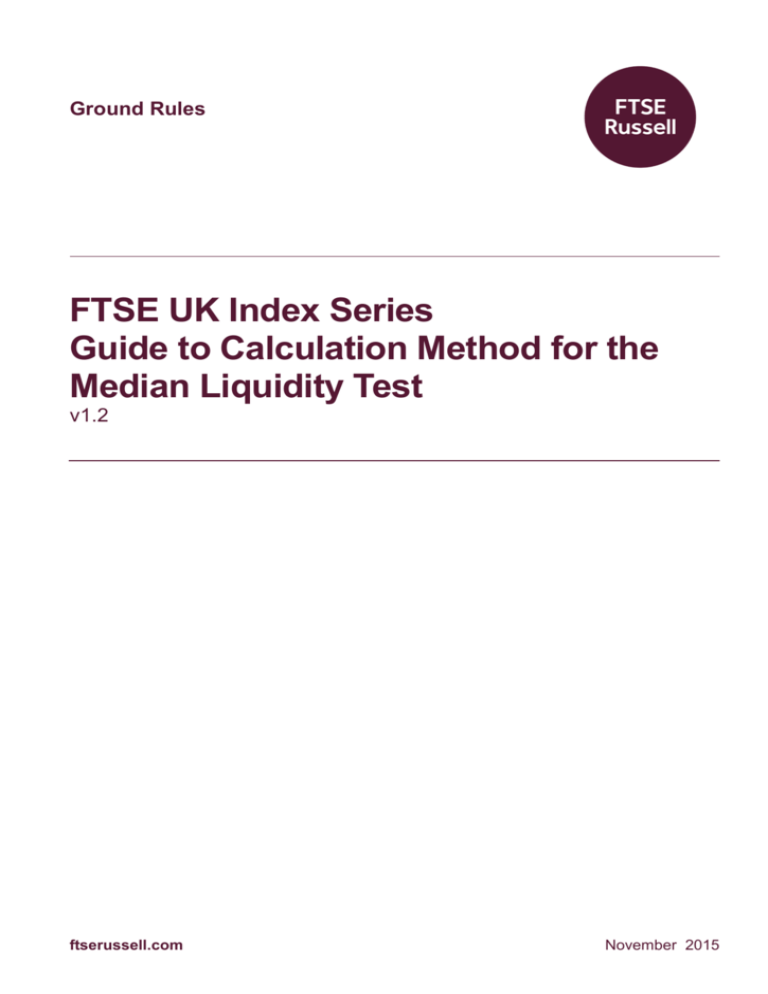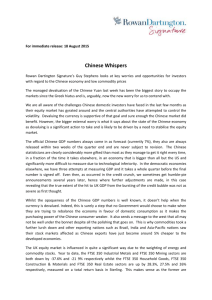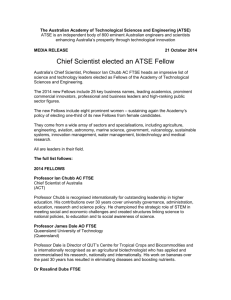
Ground Rules
FTSE UK Index Series
Guide to Calculation Method for the
Median Liquidity Test
v1.2
ftserussell.com
November 2015
Contents
1.0
Purpose of the Guide...........................................................3
2.0
Liquidity Screening Process...............................................4
3.0
Liquidity Calculation Method ..............................................6
Appendix A: Pro-Rata Pass Requirements for New Issues .......8
Appendix B: FTSE UK Index Series Liquidity –Test Cases .......9
Appendix C: Volume Data - Venues .............................................9
Appendix D: Further Information ...............................................10
FTSE Russell | Guide to Calculation Method for the Median Liquidity Test, v1.2, November 2015
2 of 10
Section 1
Purpose of the Guide
1.0
Purpose of the Guide
1.1
The aims of the guide are:
1. to describe how the liquidity test is conducted;
2. to make it easier for users to replicate the liquidity test in order to support their investment and
trading activities.
FTSE Russell | Guide to Calculation Method for the Median Liquidity Test, v1.22, November 2015
3 of 10
Section 2
Liquidity Screening Process
2.0
Liquidity Screening Process
Each security will be tested for liquidity annually in June by calculation of its monthly median of daily
trading volume.
For the annual test, liquidity will calculated from the first business day in May of the previous year to
the last business day of April in the current year.
For each month, the daily volume for each security is calculated as a percentage of the shares in
issue for that day adjusted by the free float at the end of the month. These daily values are then
ranked in descending order and the median is taken by selecting the value for the middle ranking day
if there is an odd number of days and the mean of the middle two if there is an even number of days.
Where the testing period is less than 12 months, the liquidity test will be applied on a pro-rata basis
(refer to Appendix A).
When calculating the median of daily trading volume of any security for a particular month, a minimum
of 5 trading days in that month must exist, otherwise the month will be excluded from the test.
Daily totals with zero trades are included in the ranking, therefore a security that fails to trade for more
than half of the days in a month will have a zero median trading volume for that month.
Only exchange trading days will be included in the calculation i.e. exchange holidays will be excluded.
Any period of suspension will not be included in the test.
Liquidity Thresholds:
•
A - Securities which do not turnover at least 0.025% of their shares in issue (after the application
of any investability weightings*) based on their monthly median for at least ten of the twelve
months prior to the annual index review, will not be eligible for inclusion in the FTSE UK Index
Series until the next annual review.
•
B - An existing constituent which does not turnover at least 0.015% of its shares in issue (after
the application of any investability weightings*) based on its monthly median per month for at
least eight of the twelve months prior to the annual index review will be removed and will not be
eligible for inclusion in the FTSE UK Index Series until the next annual review.
•
C - New issues which do not have a twelve month trading record must have a minimum 20 day
trading record when reviewed. They must turnover at least 0.025% of their shares in issue (after
the application of any investability weightings*) based on their monthly median each month, on a
FTSE Russell | Guide to Calculation Method for the Median Liquidity Test, v1.2, November 2015
4 of 10
pro-rata basis since premium listing or UK Nationality allocation date if non-UK incorporated
(refer to Appendix A & B). This rule will not apply to new issues added under the Fast Entry Rule
except for demutualisations (see Rule 6.5 of the FTSE UK Index Series).
•
A new issue that fails the liquidity test will not be eligible for inclusion in the UK Index
Series until the next annual review.
•
*When testing liquidity the published free float weight on the final trading day of each
month will be used for the calculation of the liquidity test for that month.
•
D - In assessing liquidity, data will be aggregated from venues exhibiting a market share of
greater than 2%, venues currently aggregated can be seen in Appendix C. If the company
fails the liquidity screen on this basis, data may also be obtained from Depository Receipt
(DR) trades. For the purpose of this rule, where the majority of trading is in the DR, 100%
of DR trading will be aggregated with 50% of the trades in the UK. Where the majority of
trading is in the UK, 50% of DR trading will be aggregated with 100% of the trades in the
UK.
•
E - At the sole discretion of FTSE, the above percentage figures may be adjusted by up to
0.01% at a market review so that, in FTSE's opinion, the index better reflects the liquid
investable market. This discretion may only be exercised across the FTSE All-Share Index
and may not be applied to individual securities. If FTSE intends to exercise this discretion,
it must make a public statement to that effect at least two weeks prior to the regular June
review meeting. Any adjusted percentage parameters will be maintained until the next
annual review.
•
F – There is no liquidity requirement for constituents of the FTSE Fledgling Index.
In assessing liquidity, data will be obtained from a constituent’s exchange in the country in which
the company is classified by FTSE. If the constituent fails the liquidity screen on this basis, data
may also be reviewed from other markets (including trading in ADRs and GDRs) and the trading
volumes aggregated for the purpose of this Rule. Trading volumes from other markets will not
normally be considered unless the majority of the liquidity is met from the constituent’s
exchange in the country in which the company is classified. When considering whether to
include liquidity from other markets, the FTSE Russell Europe, Middle East & Africa Regional
Equity Advisory Committee will take into account factors such as currency risk and time zone
difference.
FTSE Russell | Guide to Calculation Method for the Median Liquidity Test, v1.2, November 2015
5 of 10
Section 3
Liquid Calculation Method
3.0
Liquidity Calculation Method
•
For each month the daily trading of company A is analysed
Daily volume traded (000’s)
160
140
120
120
110
80
80
50
27.4
27
19.5
15
23
30
19
18
10
10
10
0
0
0
18th day
20.5
17th day
40
20th day
19th day
16th day
15th day
14th day
13th day
12th day
11th day
10th day
9th day
8th day
7th day
6th day
5th day
4th day
3rd day
2nd day
1st day
0
Daily Volumes
For each month we rank the daily volumes and select the median value
Monthly Median
=
=
10th + 11th day
2
(19,500 + 20,500)
2
= 20,000
FTSE Russell | Guide to Calculation Method for the Median Liquidity Test, v1.2, November 2015
6 of 10
Daily volume traded (000’s)
160
140
120
120
110
80
80
50
40
0
0
1st value
2nd value
3rd value
10 10 10
0
27 27.4 30
19.4 20.4 23
19
18
15
20th value
19th value
18th value
17th value
16th value
15th value
14th value
13th value
12th value
11th value
10th value
9th value
8th value
7th value
6th value
5th value
4th value
0
Monthly Median Liquidity (%) =
Monthly median of daily volumes / free float adjusted shares**
Note: ** When testing liquidity the published free float weight at the end of each month will
be used for the calculation of that month.
Assuming Company A has 40m shares in issue and a free float of 100% for the month being tested,
monthly median liquidity is:
20,000 / 40,000,000 = 0.05% (pass)
If Company A has 40m shares in issue and a free float of 50% for the month being tested, monthly
liquidity is:
20,000 / 20,000,000 = 0.1% (pass)
Assuming Company A has 100m shares in issue and a free float of 100% for the month being tested,
monthly median liquidity is:
20,000 / 100,000,000 = 0.02% (fail)
FTSE Russell | Guide to Calculation Method for the Median Liquidity Test, v1.2, November 2015
7 of 10
Appendix A: Pro-Rata Pass Requirements for
New Issues
Months Tested
1 month
Minimum Monthly Pass Rate Required
1 month
2 months
2 months
3 months
3 months
4 months
4 months
5 months
5 months
6 months
5 months
7 months
6 months
8 months
7 months
9 months
8 months
10 months
9 months
11 months
10 months
12 months
10 months
FTSE Russell | Guide to Calculation Method for the Median Liquidity Test, v1.2, November 2015
8 of 10
Appendix B: FTSE UK Index Series Liquidity –
Test Cases
Test case
Liquidity Test
New Issue / AIM Transfer /
Newly Eligible
(UK incorporated)
From date of Premium listing on Main Market
Pass = index inclusion
Fail = fail until June annual test
New Issue / AIM Transfer /
Newly Eligible
(non-UK incorporated)
From date of FTSE ‘UK’ Nationality allocation
Pass = index inclusion
Fail = fail until June annual test
Please note:
When calculating the median of daily trades per month a minimum of 5 trading days in each
month must exist, otherwise the month will be ignored and not used in the count.
Appendix C: Volume Data - Venues
Volume data from the following venues are aggregated for the purpose of the
FTSE liquidity test:
London Stock Exchange
BATS Chi-X CXE
BATS Chi-X BXE
BATS Chi-X OTC
BOAT Services
Turquoise
FTSE Russell | Guide to Calculation Method for the Median Liquidity Test, v1.2, November 2015
9 of 10
Appendix D: Further Information
A Glossary of Terms used in FTSE’s Ground Rule documents can be found using the following link:
http://www.ftse.com/products/downloads/Glossary.pdf
Further information on the FTSE UK Index Series is available from FTSE Russell.
For contact details please visit the FTSE Russell website or contact FTSE client services at info@ftse.com.
Website: www.ftserussell.com
FTSE Russell
FTSE Russell is a trading name of Frank Russell Company (FRC), FTSE International Limited (FTSE) and FTSE
TMX Global Debt Capital Markets, Inc. (FTSE TMX). FRC, FTSE and FTSE TMX are each benchmark
administrators of indexes. References to FTSE Russell should be interpreted as a reference to the relevant
benchmark administrator for the relevant index.
© 2015 London Stock Exchange Group companies. All rights reserved.
The FTSE UK Index Series is calculated by FTSE International Limited “FTSE” or its agent. All rights in the Index Series vest in FTSE.
London Stock Exchange Group companies includes FTSE International Limited (“FTSE”), Frank Russell Company (“Russell”), MTS Next
Limited (“MTS”), and FTSE TMX Global Debt Capital Markets Inc. (“FTSE TMX”). All rights reserved.
“FTSE®”, “Russell®”, “MTS®”, “FTSE TMX®” and “FTSE Russell” and other service marks and trademarks related to the FTSE or Russell
indexes are trade marks of the London Stock Exchange Group companies and are used by FTSE, MTS, FTSE TMX and Russell under
licence.
All information is provided for information purposes only. Every effort is made to ensure that all information given in this publication is
accurate, but no responsibility or liability can be accepted by the London Stock Exchange Group companies nor its licensors for any errors or
for any loss from use of this publication.
Neither the London Stock Exchange Group companies nor any of their licensors make any claim, prediction, warranty or representation
whatsoever, expressly or impliedly, either as to the results to be obtained from the use of the FTSE UK Index Series or the fitness or suitability
of the Indexes for any particular purpose to which they might be put.
The London Stock Exchange Group companies do not provide investment advice and nothing in this document should be taken as
constituting financial or investment advice. The London Stock Exchange Group companies make no representation regarding the advisability
of investing in any asset. A decision to invest in any such asset should not be made in reliance on any information herein. Indexes cannot be
invested in directly. Inclusion of an asset in an index is not a recommendation to buy, sell or hold that asset. The general information
contained in this publication should not be acted upon without obtaining specific legal, tax, and investment advice from a licensed
professional.
No part of this information may be reproduced, stored in a retrieval system or transmitted in any form or by any means, electronic, mechanical,
photocopying, recording or otherwise, without prior written permission of the London Stock Exchange Group companies. Distribution of the
London Stock Exchange Group companies’ index values and the use of their indexes to create financial products require a licence with FTSE,
FTSE TMX, MTS and/or Russell and/or its licensors.
The Industry Classification Benchmark (“ICB”) is owned by FTSE. FTSE does not accept any liability to any person for any loss or damage
arising out of any error or omission in the ICB.
FTSE Russell | Guide to Calculation Method for the Median Liquidity Test, v1.2, November 2015
10 of 10








